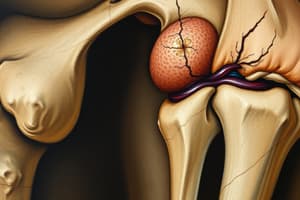Podcast
Questions and Answers
What is the initial step in the fracture healing process?
What is the initial step in the fracture healing process?
- Bone remodeling
- Hematoma formation
- Bony callus formation (correct)
- Granulation tissue formation
Which type of tissue plays a crucial role in providing initial stability at the fractured bone site?
Which type of tissue plays a crucial role in providing initial stability at the fractured bone site?
- Bony callus
- Granulation tissue
- Osteoblasts
- Fibrous callus (correct)
What is the function of granulation tissue in the fracture healing process?
What is the function of granulation tissue in the fracture healing process?
- Bridge the gap between fractured bone ends (correct)
- Depositing new bone tissue
- Enable bone remodeling
- Providing initial stability
How do mechanical stability and strain influence fracture healing?
How do mechanical stability and strain influence fracture healing?
What factor can lead to malunion in fractures?
What factor can lead to malunion in fractures?
How do infection, tumors, and disrupted vascular supply affect fracture healing?
How do infection, tumors, and disrupted vascular supply affect fracture healing?
Which type of bone healing involves Haversian remodeling?
Which type of bone healing involves Haversian remodeling?
What is the range of mechanical strain typically achieved in primary bone healing?
What is the range of mechanical strain typically achieved in primary bone healing?
Which of the following fixation modalities is associated with secondary bone healing?
Which of the following fixation modalities is associated with secondary bone healing?
Endochondral ossification is bypassed in which type of bone healing?
Endochondral ossification is bypassed in which type of bone healing?
What factor determines the choice between primary and secondary bone healing?
What factor determines the choice between primary and secondary bone healing?
Which type of bone healing involves a mechanical strain range of 2-10%?
Which type of bone healing involves a mechanical strain range of 2-10%?
Flashcards are hidden until you start studying
Study Notes
Fracture Healing: Understanding the Process and Types
Bone fracture healing is a complex and fascinating process that involves the body's ability to regenerate and repair damaged bone tissue. This process is essential for maintaining skeletal integrity and function, especially after an injury or trauma. The journey from a fracture to a healed bone involves several steps and factors, each with its unique characteristics and implications for the overall healing process.
Types of Fracture Healing
There are two primary modes of bone healing: primary and secondary. The choice of healing mode is determined by the mechanical stability at the fracture site.
Primary Bone Healing
Primary bone healing, also known as intramembranous bone healing, occurs through Haversian remodeling. This type of healing is characterized by absolute stability constructs that achieve a mechanical strain below 2%, resulting in an intramembranous bone healing process. Primary bone healing is a more straightforward process as it bypasses the endochondral ossification phase, which is involved in secondary bone healing.
Secondary Bone Healing
Secondary bone healing, also called endochondral bone healing, occurs in non-rigid fixation modalities such as braces, external fixation, plates in bridging mode, and intramedullary nailing. These fixation modalities achieve a mechanical strain between 2-10%, which initiates the endochondral ossification process.
The Healing Process
Fracture healing begins with a hematoma, a temporary blood clot that forms at the site of the fracture. This clot later becomes a fibrous callus, which is a soft tissue that plays a crucial role in providing initial stability and preventing further movement of the fractured bone.
The next step in the healing process is granulation tissue formation. Granulation tissue is a highly vascularized connective tissue that forms in response to tissue injury. This tissue helps to bridge the gap between the two ends of the fractured bone and provides a scaffold for the growth of new bone tissue.
Bony callus formation is the next stage of the healing process, where the callus becomes calcified and ossified. Osteoblasts, the cells responsible for bone formation, begin to deposit new bone tissue, gradually replacing the fibrous callus with a bony one.
Finally, bone remodeling occurs, where the newly formed bone tissue undergoes a process of resorption and formation to become the mature bone structure. This process ensures the bone regains its strength and structure, adapting to the specific mechanical demands of the individual.
Factors Affecting Fracture Healing
Several factors influence the process of fracture healing, including:
Mechanical Stability
Mechanical stability at the fracture site is critical for proper healing. An appropriate mechanical stimulation, such as strain, facilitates tissue formation at the bony ends. The involved strain determines the biological behavior of the cells involved in the healing process and the type of bone healing.
Age and Sex
Fracture healing can be influenced by age and sex. Older individuals and females have a higher risk of delayed or failed healing due to decreased bone density and microarchitecture, lower bone turnover rates, and reduced proteostasis.
Bone Location and Comminution
The location of the fracture and the level of comminution (the degree of bone fragmentation) can also affect the healing process. Fractures in locations with minimal surrounding vascularized tissue, such as the femoral neck and mid-diaphyseal tibia, are more likely to proceed to malunion (a fracture that heals in an extra-articular position).
Infection and Other Factors
Infection, tumors, and disrupted vascular supply can also affect the healing process and lead to failed or delayed healing. These factors can contribute to up to 10% of all fractures.
Conclusion
Bone fracture healing is a complex and intricate process that involves multiple stages, factors, and modes of healing. Understanding these factors and their implications is crucial for the successful treatment and management of fractures. As research continues, we can expect to gain further insights into the intricacies of fracture healing and develop more effective strategies for enhancing bone repair and regeneration.
Studying That Suits You
Use AI to generate personalized quizzes and flashcards to suit your learning preferences.




